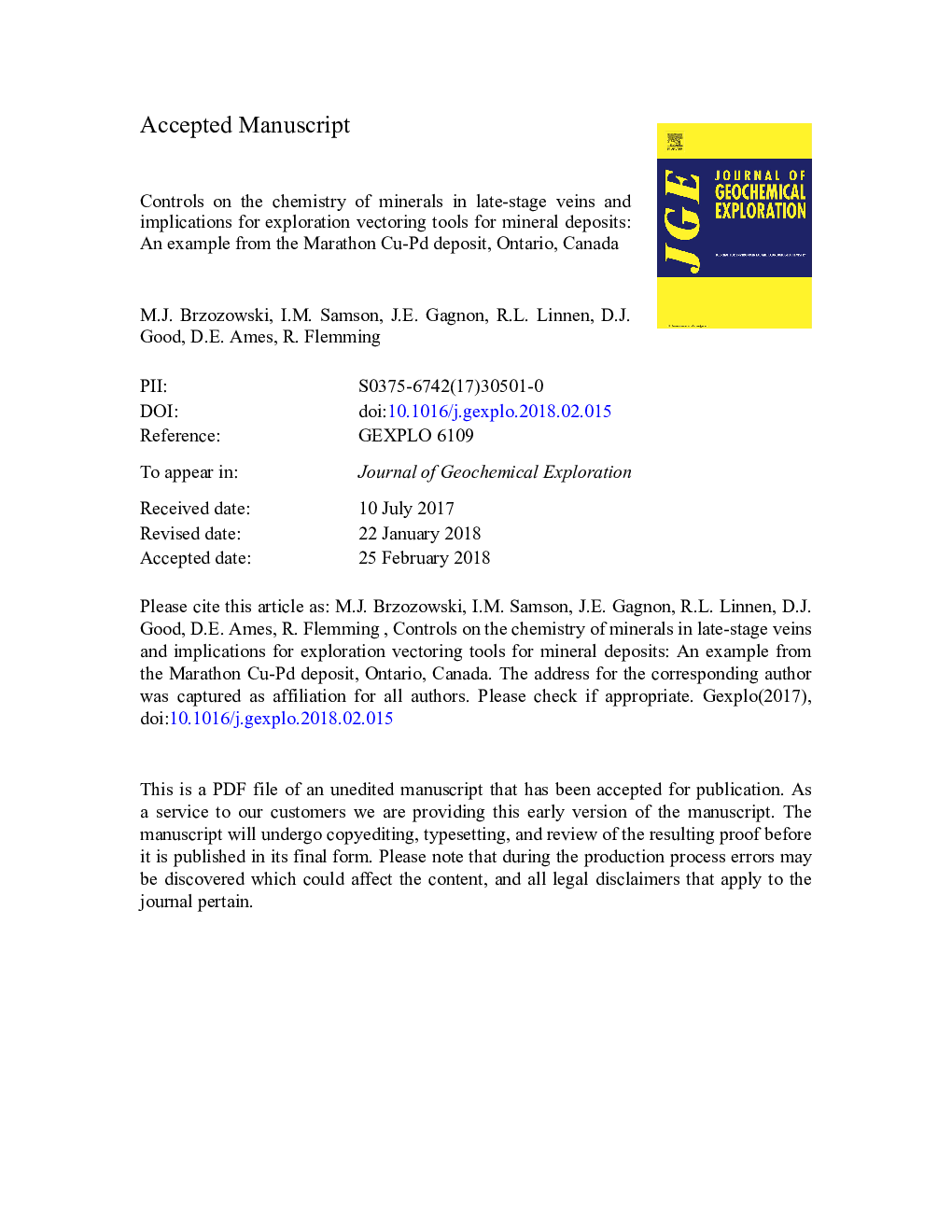| کد مقاله | کد نشریه | سال انتشار | مقاله انگلیسی | نسخه تمام متن |
|---|---|---|---|---|
| 8865886 | 1620867 | 2018 | 53 صفحه PDF | دانلود رایگان |
عنوان انگلیسی مقاله ISI
Controls on the chemistry of minerals in late-stage veins and implications for exploration vectoring tools for mineral deposits: An example from the Marathon Cu-Pd deposit, Ontario, Canada
دانلود مقاله + سفارش ترجمه
دانلود مقاله ISI انگلیسی
رایگان برای ایرانیان
کلمات کلیدی
موضوعات مرتبط
مهندسی و علوم پایه
علوم زمین و سیارات
زمین شناسی اقتصادی
پیش نمایش صفحه اول مقاله

چکیده انگلیسی
In and around the Marathon Cu-Pd deposit, veins consist of a complex mixture of phyllo and chain silicates, including chlorite, serpentine, saponite, and Ca-rich amphibole, whereas disseminated alteration consists predominantly of Ca-rich amphibole with lesser chlorite. The abundance of these veins is inversely correlated with the presence of mineralization. Minerals hosted in veins and patchy alteration crystallized from different fluids during temporally distinct events; the veins formed later than the disseminated alteration and from multiple stages of lower-temperature fluids. There is no correlation between the rock types that the veins are hosted by and the composition of the vein minerals, but on a very local scale, the mineral that a vein is hosted by does exhibit a compositional control. Vein minerals that are hosted by magnetite, and to a lesser extent, pyroxene, are enriched in Ti, V, and Cr compared to those hosted by plagioclase. In vein minerals that are hosted by plagioclase, the concentration of Co, Ni, and Zn increase systematically with distance from mineralization. The concentrations of Co, Ni, and Zn in vein minerals hosted by plagioclase also, however, increase systematically with distance from the contact between the mineralized pluton and the underlying Archean country rocks (i.e., the footwall contact). This suggests that the Co, Ni, and Zn in the fluids were likely derived by progressive leaching from pyroxene, olivine, and magnetite as the fluid migrated upwards through the pluton, rather than from the mineralization. Consequently, the correlation between vein-hosted mineral chemistry and sulfide mineralization are misleading. The only vein characteristic that can be used as an exploration tool at Marathon is the inverse correlation between vein density and zones of sulfide mineralization. This study demonstrates that the application of vein and mineral chemistry to mineral exploration needs to be carried out in the context of a careful assessment of the variations and controls on mineral chemistry from the scale of the deposit and its surrounding rocks down to the grain-scale.
ناشر
Database: Elsevier - ScienceDirect (ساینس دایرکت)
Journal: Journal of Geochemical Exploration - Volume 190, July 2018, Pages 109-129
Journal: Journal of Geochemical Exploration - Volume 190, July 2018, Pages 109-129
نویسندگان
M.J. Brzozowski, I.M. Samson, J.E. Gagnon, R.L. Linnen, D.J. Good, D.E. Ames, R. Flemming,